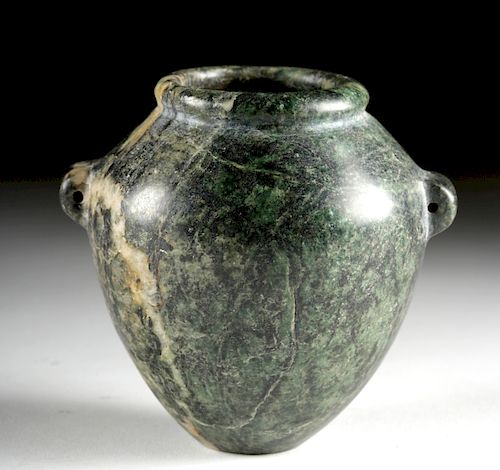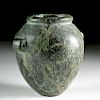Egyptian Pre-Dynastic Serpentine Acorn Shaped Jar
Lot 1
About Seller
Artemis Fine Arts
686 S Taylor Ave, Ste 106
Louisville, CO 80027
United States
Selling antiquities, ancient and ethnographic art online since 1993, Artemis Gallery specializes in Classical Antiquities (Egyptian, Greek, Roman, Near Eastern), Asian, Pre-Columbian, African / Tribal / Oceanographic art. Our extensive inventory includes pottery, stone, metal, wood, glass and textil...Read more
Estimate:
$3,000 - $4,500
Absentee vs Live bid
Two ways to bid:
- Leave a max absentee bid and the platform will bid on your behalf up to your maximum bid during the live auction.
- Bid live during the auction and your bids will be submitted real-time to the auctioneer.
Bid Increments
| Price | Bid Increment |
|---|---|
| $0 | $25 |
| $300 | $50 |
| $1,000 | $100 |
| $2,000 | $250 |
| $5,000 | $500 |
| $10,000 | $1,000 |
| $20,000 | $2,500 |
| $50,000 | $5,000 |
| $100,000 | $10,000 |
| $200,000 | $20,000 |
About Auction
By Artemis Fine Arts
Feb 21, 2019
Set Reminder
2019-02-21 10:00:00
2019-02-21 10:00:00
America/New_York
Bidsquare
Bidsquare : Exceptional Antiquities, Asian, Ethnographic
https://www.bidsquare.com/auctions/artemis-gallery/exceptional-antiquities-asian-ethnographic-3858
An important one-day auction featuring museum-worthy examples of Egyptian, Greek, Roman, Etruscan, Near Eastern, Far East / Asian, Pre-Columbian, African / Tribal, Oceanic, Native American, Spanish Colonial, Russian, Fossils, Ancient Jewelry, Fine Art, so much more! Artemis Fine Arts info@artemisgallery.com
An important one-day auction featuring museum-worthy examples of Egyptian, Greek, Roman, Etruscan, Near Eastern, Far East / Asian, Pre-Columbian, African / Tribal, Oceanic, Native American, Spanish Colonial, Russian, Fossils, Ancient Jewelry, Fine Art, so much more! Artemis Fine Arts info@artemisgallery.com
- Lot Description
Ancient Egypt, Pre-Dynastic Period, Naqada II, ca. 3500 BCE. A beautifully carved serpentine jar, shaped like an acorn, with perforated lug handles on its shoulders, a round, flat base, and a rimmed collar. The stone is a beautiful, mottled green with cream-colored veins. The carving is so delicate and skillful, the walls of the vessel so thin, that light shines through the creamy areas of the walls. Size: 3.9" W x 3.95" H (9.9 cm x 10 cm)
In addition to being quite striking, this jar represents a technological leap forward for the ancient Egyptians. In the early Pre-Dynastic, artisans hollowed out hard stone vessels using hand-held stone borders and abrasive desert sand. Then, during the Naqada II period (ca. 3600 to 3200 BCE), the invention of copper tubes used to drill very hard stones (in conjunction with sand as an abrasive), allowed people to drill finer forms - like, for example, these lugged handles. However, copper drills only allowed artisans to drill cylindrical items, and so the hollowing out of bulbous vessels like this one still required use of an elongated stone borer in the form of a figure-of-eight. Imagine the hours of work that went into making this single jar!
Provenance: private Chicago, Illinois, USA collection; ex-Arte Primitivo Gallery New York, USA; ex-private New York, USA collection, acquired pre-1948
All items legal to buy/sell under U.S. Statute covering cultural patrimony Code 2600, CHAPTER 14, and are guaranteed to be as described or your money back.
A Certificate of Authenticity will accompany all winning bids.
We ship worldwide and handle all shipping in-house for your convenience.
#143134Light signs of wear on surface, with small areas of deposits, notably around the handles. Old collection number on base.Condition
- Shipping Info
-
All shipping is handled in-house for your convenience. Your invoice from Artemis Gallery will include shipping calculation instructions. If in doubt, please inquire BEFORE bidding for estimated shipping costs for individual items.
-
- Buyer's Premium



 EUR
EUR CAD
CAD AUD
AUD GBP
GBP MXN
MXN HKD
HKD CNY
CNY MYR
MYR SEK
SEK SGD
SGD CHF
CHF THB
THB














